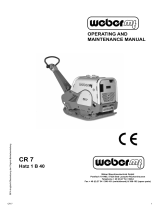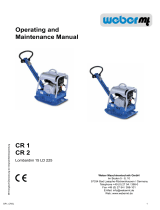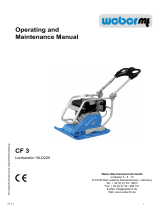Page is loading ...

CR 9 1
CR 9
Hatz 1 D 90
0313/englisch/Übersetzung der Original-Betriebsanleitung
Operating and
Maintenance Manual
Weber Maschinentechnik GmbH
Im Boden 5 - 8, 10
57334 Bad Laasphe-Rückershausen / Germany
Telephone +49 (0) 27 54 / 398-0
Fax +49 (0) 27 54 / 398-101
E-Mail: [email protected]
Web: www.webermt.de

2 CR 9

CR 9 3
Table of contents
Introduction 4
Safety guidelines 5
Graphic presentation 8
Device description 9
Technical data 10
Activities prior to starting work 12
Starting 14
Compacting 15
Taking out of operation 15
Maintenance overview 16
Maintenance work 17
Operating uids and ll levels 21
Troubleshooting 22
Storage 23
Circuit diagram 25
Contact addresses 27

4 CR 9
Introduction
This operating and maintenance manual is designed to facilitate familiarization with your soil compactor,
and to enable you to maintain the compactor and use it for its intended purpose.
When complying with the instructions in the operating and maintenance manual you help avoid hazards,
reduce repair and downtime costs, and increase the reliability and service life of your compactor.
This operating and maintenance manual must always be available at the implementation site of the
soil compactor.
If necessary you can obtain additional information from your authorized WEBER dealer, or you can
obtain information from one of the contact addresses on the last page.
The valid conformity declaration is enclosed with every machine delivery.
You can obtain information on the assembled Hatz diesel engine at www.hatz-diesel.com

CR 9 5
Safety guidelines
General
All safety instructions must be read and complied with, non-compliance results in
– Danger to life and limb of the user
– Impairments to the machine or other property.
In addition to the operating manual, the accident-prevention regulations in the country where the
appliance is used must be complied with.
Intended use
The soil compactor should only be used in technically faultless condition, as intended, in a safety-
conscious and hazard-conscious manner, in compliance with the instructions in the operating manual.
Malfunctions that impair safety must be eliminated without delay.
The CR 9 soil compactor is designed exclusively for compacting
– Sand
– Gravel
– Crushed rock
– Semi-cohesive mixed material.
Any other use of the soil compactor is considered to be improper use for which the owner shall be
exclusively responsible. All liability is rejected if damage occurs due to non-compliance with this
provision. This risk is borne solely by the user.
Easily foreseeable misuse
Any use for which the machine is not intended.
Operation
Soil compactors should only be operated by suitable personnel of at least 18 years of age. Personnel
must be instructed in how to guide the compactor by the owner or by the owner‘s assigned personnel.
The machine operator must comply with trafc regulations. If instructions that affect safety are given
by third persons, then the operator must be authorized to reject these instructions.
Unauthorized persons are forbidden from being in the area of the soil compactor during the
compacting process.
Protective equipment
This machine is capable of exceeding the permissible sound level of 80 dB(A). The owner might also
face additional dangers when using the machine. Precautionary action must, therefore, be taken.
Protective equipment includes:
Hearing protection
Hard hat
Safety shoes
Protective gloves

6 CR 9
Maintenance and repair work
Only use original Weber spare parts to ensure reliable and safe operation for maintenance or repair
work.
Hydraulic hose lines must be checked at regular intervals in accordance with standard engineering
practice, or they must be replaced at appropriate intervals, even if no signs of safety-relevant defects
are present.
Adjusting tasks, service tasks, and inspection tasks must be executed on schedule in accordance
with the service display in the COMPATROL® display instrument or as specied in this operating and
service manual. These activities should only be executed by instructed personnel.
For repair, maintenance, or inspection work the engine of the compactor must be safeguarded
against unintentional starting.
All pressurized lines, particularly hydraulic lines and lines of the injection system of the drive motor
must be depressurized before performing maintenance or repair tasks.
For maintenance and repair tasks the compactor must be parked on a level and stable substrate and
must be secured from rolling off or tipping over.
Heavy components and subassemblies must be secured on hoisting machines with adequate bearing
capacity when they are replaced. Ensure that no hazard exists related to the raised components or
subassemblies.
Do not position yourself or work under suspended loads.
Operation under difcult conditions
Never inhale the exhaust gas; it contains carbon monoxide, a colorless and odorless gas that is
extremely hazardous, which if inhaled even briey can cause unconsciousness and death.
Never operate the engine in enclosed areas or in areas that are poorly ventilated (tunnels, caves,
etc.) Exercise particular caution when operating the engine in the vicinity of people and livestock.
Operation
Prior to starting work the owner of the compactor must be familiar with the work environment.
The work environment includes obstacles in the work and trafc area, the bearing capacity of
the ground, as well as the necessary safeguarding of the construction site in the area adjacent to
public trafc; and it includes compliance with trafc regulations.
The soil compactor should only be operated when the protective xtures are mounted. The protective
xtures must all be in functional condition.
At least once per shift the compactor must be checked for apparent defects. If there are apparent
defects then operation of the compactor must be stopped immediately and the responsible person
must be informed. Prior to restarting, compactor malfunctions that have occurred must be corrected.
Always maintain adequate clearance to the edges of pits and embankments.
Do not drive at ninety degrees to slopes to prevent the compactor from tipping over.
After work has been concluded secure the compactor in accordance with statutory regulations,
particularly in the area of public trafc surfaces.
If lubricating oils and fuel come into contact with skin, they can cause skin cancer. Upon contact
with the skin, clean affected skin with suitable cleaning agent without delay.

CR 9 7
Inspection
Compactors must be inspected in accordance with appropriate implementation conditions and
operating conditions, as needed; however an inspection to ensure operationally safe status must be
performed by an expert at least once a year. The results of the inspection must be recorded in
writing and must be stored at least until the next inspection.
Cleaning work
Prior to cleaning the compactor with a high-pressure cleaner, protect all accessible energized
switches, cable connections, etc. against water penetration by masking them off.
Cleaning tasks should only be executed in areas that are suitable and have been approved for this
purpose (oil separator amongst others).
Disposal
All operating uids and auxiliary materials must be disposed of in an environmentally-compatible
manner in accordance with country-specic regulations.
Warning against irritants or materials hazardous to health
Warning against a hazardous place
Warning against a suspended load
Wear ear protection
General regulation
Environmental protection
Hard hat
Safety shoes
Protective gloves
Important information for operating and maintenance personnel is marked by pictograms.

8 CR 9
912
7
42
3
6
8
10
5
13
14
16
15
Graphic presentation
Overall view CR 9
1 Engine (no image)
2 Rocker switch
3 Manual guidance rod
4 Lifting ring
5 Handle
6 Base plate
7 Protective frame
8 Exciter
9 Gas lever
10 Attachment plates
11 Fuse holders (no image)
12 Hearing protection (sticker)
13 Maintenance cover
14 Side panel
15 Ignition module
16 Operating hours counter

CR 9 9
Device description
The CR 9 compactor is used for road building and landscaping compaction tasks.
Drive
The compactor is propelled by an air-cooled Hatz diesel engine.
Force is transferred to the exciter mechanically via a V-belt.
Operation
Start the Hatz diesel engine via the electrical start device.
After starting, vibration is switched on via the centrifugal clutch attached to the engine. Use the gas
lever to vary the engine speed between idle and full throttle.
Forward and reverse is variably controlled via the rocker switch attached to the manual guidance rod.

10 CR 9
Technical data
CR 9
Weight
Operating weight CECE in kg 740
Dimensions
Overall length (in mm) 1867
Working width – basic device (in mm) 650
Working width – basic device with
attachment plates (in mm) 750 / 900
Height with folded manual guidance rod (in mm) 1167
Base plate length (base in mm) 450
Drive
Engine manufacturer Hatz
Type 1 D 90
Performance at operating speed in accordance with
ISO 3046-1 (kW) 11
Combustion process 4-stroke diesel
Operating speed (1/min) 2900
Operating speed (ground-dependent in m/min) 28
Incline capacity (ground-dependent in %) 30
Depth of effect (in cm) 80
Area capacity (in m²/h) 1260
Vibration
System Two-wave vibrator
Drive concept Mechanical
Frequency (in Hz) 65
Centrifugal force (in kN) 100
CR 9
Noise emissions in accordance with 2000/14/EC
99
109
Sound pressure level LPA ascertained in accordance
with EN 500, in dB (A)
Sound power level LWA ascertained in accordance
with EN ISO 3744 and EN 500, in dB (A)
Vibration values
3.6
Root-mean-square acceleration value for
hand-arm vibration ascertained in accordance
with EN 500 in m/s²
Directive 2006/42/EC has to be complied
with by the owner.

CR 9 11
2
1
34
56
1 Description 2 TYPE
.......................................................... ..........................................................
3 Serial number 4 Year of manufacture
.......................................................... ..........................................................
5 Weight 6 Rated power kW
.......................................................... ..........................................................

12 CR 9
1
1
1
2
Transport
Fit the crane hook into the lifting ring (1) and lift the machine
onto the desired means of transport.
Only use lifting machines with a minimum bearing
capacity of 1000 kg.
Adjust the desired work height of the manual guidance rod
with the set screw (1).
Adjusting the manual guidance rod
Arrest the manual guidance rod (1) with the spring bolt (2).
When transporting the soil compactor on a vehicle,
secure it with suitable restraints.
Do not step under suspended loads.
Activities prior to starting work

CR 9 13
min max
1
2
1
Checking the engine oil level
Pull the oil dip stick out of the crankcase.
The correct oil level is between the min. and max.
marks.
Open the cover (1), unscrew and remove the gas cap
(2), check the ll level and, if necessary, top off with
clean fuel to the lower edge of the ller neck in accord-
ance with the specication.
Checking the fuel level
For work at the fuel system, have a suitable
re-extinguishing agent at the ready.
Fire, naked light, and smoking is forbidden!
Fold the maintenance cover (1) forward.

14 CR 9
1
1
3
24
5
If the ignition key does not bounce back to pos. 1 – turn
off the machine immediately – danger of starter damage
due to the starter also running during operation.
Start for a maximum of twenty seconds without interrup-
tion. If the engine does not start, repeat starting process
after a minute. If the engine does not start after two start
processes, seek cause in fault table.
Insert the ignition key (1) and turn to position 1.
Turn the ignition key (1) to position 2.
The ignition key must bounce back to pos. 1 and remain
in this position during operation. The charge level indi-
cator (4) and the oil pressure indicator (3) must go out
immediately after starting.
The indicator lamp (2) lights up, indicating that the engine is
in operation.
The operating hours counter (5) will keep counting the
operating hours as long as the ignition is switched on.
Release the ignition key as soon as the engine starts
After turning on the ignition, you will be shown the time
remaining until the next maintenance inspection in eld
5 for 10 s.
Starting
Open the vandalism ap (1).
Bring the gas lever into full-throttle position.
Mounting the attachment plates
Tighten the screws of the attachment plates with a torque
of 425 NM.

CR 9 15
1
1
2
1
1
1
1
Compacting
Use the rocker switch (1) to control the drive speed.
Only run machine within reach (2) of the manual
guidance rod.
Pressing the impact plate (1) will automatically switch
the machine into forward motion in the direction
of travel.
Shutting down
Bring the gas lever (1) into idle position (pull towards the
operator).
Close the vandalism ap (1) and lock with a padlock.
During breaks – even if they are short – the machine
must be shut down.
Parked devices that represent an obstacle must
be safeguarded against through conspicuous meas-
ures.
Turn the ignition key (1) from position “1” to position “0”.
Pull out the ignition key.
To turn off the engine drag the button (1).

16 CR 9
Maintenance overview
Maintenance interval Maintenance point Maintenance activity
After the rst
25 operating hours
Engine – Change engine oil
–Re-tighten all accessible
threaded connections
Every 8 operating
hours / daily
Air lter
–
Clean air lter insert,
check for damage,
replace if necessary
Every 150 operating
hours / every 6 months
Engine – Change engine oil
–Change the fuel lter
–Change oil lter
Battery
–
Check acid level,
ll up with distilled
water if necessary
Transmission – Check oil level
Every 150 operating
hours / every year
Transmission – Change oil
Exciter – Change oil
The regulations of the engine manufacturer must be complied with in addition to the above main-
tenance overview!
Work must be carried out using regulation tools and the operating and maintenance manual
must be complied with for all work.
All maintenance work: Select a collection vessel that is large enough to prevent oil from spilling onto
the ground. Dispose of waste oil in an environmentally friendly manner (regulation on waste oils).
Dispose of oils, greases, cloths soaked in oil, and replaced parts with oil on them in an environ-
mentally friendly manner.
If lubricating oils and fuel come into contact with skin, they can cause skin cancer. Upon contact
with the skin, clean affected skin with suitable cleaning agent without delay.
If accessible during maintenance, check the condition and stability of all screws.

CR 9 17
1
1
1
2
2
Maintenance work
Changing the engine oil
Remove side panel (1) and open maintenance cover (2)
(fold forward).
Open the cover cap (1) of the oil lter.
Screw the oil drain pipe (1) onto the engine drain valve (2) and
drain off the oil.
After emptying completely, unscrew the oil drain pipe from the
drain valve and screw the cover cap back onto the drain valve.
Fill with oil in accordance with the specication.
Only drain engine oil when at operating temperature.

18 CR 9
1
1
1
1
2
2
1
2
Pull the fuel line (2) off the fuel lter (1) on both sides.
Replace the lter with a new lter element.
Changing the fuel lter
If lubricating oils and fuel come into contact with skin, they
can cause skin cancer. Upon contact with the skin, clean
affected skin with suitable cleaning agent without delay.
Changing the engine oil lter
Pay attention to the “TOP” marking on the oil lter!
When working in the area of the engine compartment
there is a danger of being burnt!
Danger of scalding due to hot oil.
Replace oil lter (2) with a new element.
After replacing the lter element seal the lter enclosure with
the cover cap (1).
Drain engine oil.
Remove the cover cap (1).
Cleaning / changing air lter cartridge
Checking the battery / acid level
Unscrew the air lter cover (1).
Remove the air lter insert (1) from the air lter enclosure.
Clean air lter insert as specied by the engine manufacturer
if there is damage or if it is extremely dirty.
Dispose of oils, greases, cloths soaked in oil, and re-
placed parts with oil on them in an environmentally
friendly manner.
Battery acid is extremely caustic. Protect hands and eyes
with suitable protective goggles and gloves.
Remove the cover cap (1).
Check acid level. If insufcient, ll to max. mark with distilled
water.

CR 9 19
1
1
1
1
Changing the oil in the exciter
Remove the oil drain screw (1) and drain oil.
To ll – tilt the machine slightly and ll with fresh oil through
the drain opening in accordance with the ll level table.
Select a collection vessel that is large enough to pre-
vent oil from spilling on the ground. Dispose of waste
oil in an environmentally friendly manner (regulation on
waste oils).
Wipe up / off oil slick and oil residue and dispose
of fuel-soaked cleaning cloths in an environmentally
responsible manner.
Changing the fuse
Remove the protective caps (1) of the fuse holders.
Insert new fuse with a rated value of 20 Amp. / 3 Amp.
The fuses are housed behind the side panel on the left
in the direction of travel.
Remove the instrument panel (1).
Checking the hydraulic uid level
Remove the oil dip stick (1).
The correct oil level is between the min. and max. marks.

20 CR 9
1
1
Checking the V-belt
Remove the V-belt guard (1).
Check the V-belt (1) for cracks, damaged anks, and wear.
If there is excessive wear – replace the V-belt as specied in
the repair manual.
/













